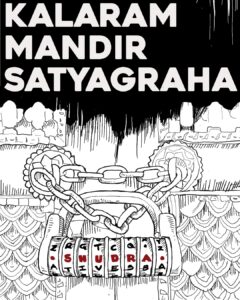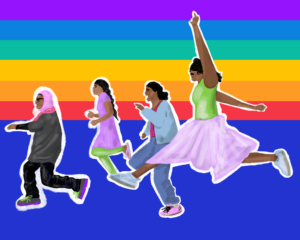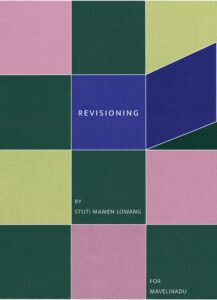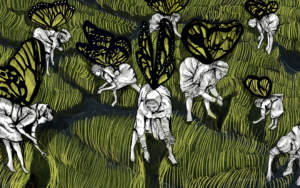It is the marginalized millions within the given nation-state that challenge its imposed uniformity & enforced uniform nationalism by asserting the right to touch, to see & be seen, to voice out & be heard beyond the negligible that’s sanctioned.
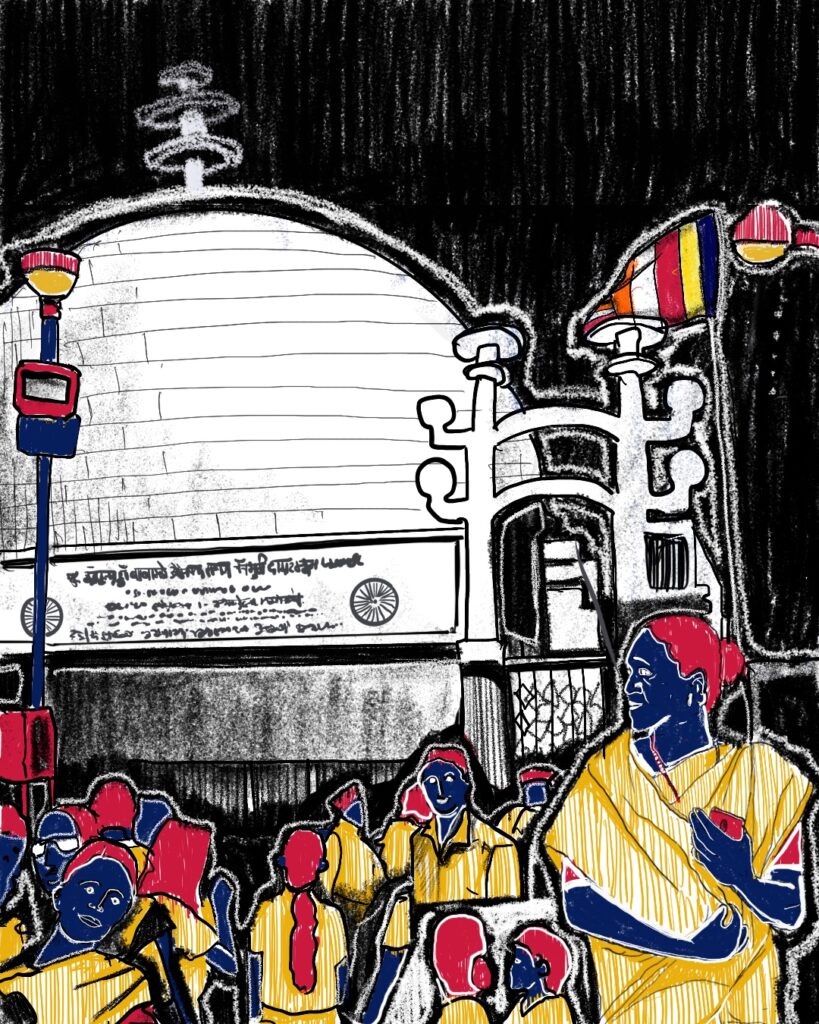
Illustration by Ajinkya Dekhane
Citizenship as Caste-Hindu Nationalism
The re/production of nation-states has turned all of us from being mere humans to citizens. Some of us were not even considered as humans by the Hindu religious texts and their governers and upholders, but only as untouchables, outcastes, slaves and merely governed bodies. It is only the sovereignty of the Indian state and its constitution, which not only recognized us as humans, but also as citizens. Citizenship, we might not have actively consented for, but may have come to entitle us something which many of us were stripped off in our enforced slavery and untouchability. But what does this nation-state take from us in return to recognize us as humans and citizens, entitle us our right? What is a nation-state at all?
Nation-state is not a physical entity that we can touch, but it exists in a meta realm, where it certainly can dictate who can be touched.
In a sense, caste also forms a sort of state; as both, too anarchical in the absence of an absolute governor or dictator, and too ordered- even with its absence, there exists a graded hierarchy that rules all. State like the religion, except untouchability and slavery is not embedded in the script it follows (the Indian Constitution), unlike of Hindu religion. This is why Dr Ambedkar, the founder of the Indian nation-state, had fought to have democracy for the governance of the ideology of the nation-state first, and the nation-state to guarantee the rights and entitlements of the citizens. But he also cautioned us about the power of this nation-state and its government, which in bad hands can make the lives of its citizens disastrous.
In our nation-state, citizenship is reiterated in everyday exchanges; a government document may ask you to confirm your ‘Nationality’ as you fill a form, as may your job or college application – or a Bollywood movie will urge you to prove your nationalism inorder to earn a respectable citizenship, and a dignified identity/living. Citizenship is thereby reaffirmed through nationality & nationalism as we speak. Nation-states and nationalists aim to construct a uniform nation, and thereby uniform nationalism by creating an ideal model for citizenship and ideal citizens- and in the process, govern and dictate human touch, sight and speech, and ultimately, the body.
The beauty of our constitution is affirming “we the people of India” which could instead be “we the citizens of India”, and asserting that this is the people (even those who aren’t recognised as citizens yet, or mis-recognized) can and shall constitute India as it is promised. Thus, it is only the marginalized millions within the given nation-state that challenge its imposed uniformity & enforced uniform nationalism by asserting the right to touch, to see & be seen, to voice out & be heard beyond the negligible that’s sanctioned. India, since its Independence, has been constructing and reconstructing different models of citizenship through various acts which lead to recognition of identities or communities, their rights, entitlements and duties, or dismissal of all of the above. In India, (nation-state and its government in bad hands) the re/construction happens through a hegemonic derivation of nationalism, which is rooted in caste-Hindu ideology.
Anti-caste, ‘Anti-national’ and Trans-gression
The proposed Transgender Persons (Protection of Rights) Bill from 2016 till 2019 mandated that the deciding authority on the person’s identity would be the state – the District Magistrate who would issue a certificate based on the recommendation of a ‘screening committee’. The committee would comprise a medical officer, a government official, a psychologist or psychiatrist, a district welfare officer and a transgender person, each of who would verify/authenticate the ‘trans-ness’ of the person. The question arises – why was the state determined to regulate trans bodies by limiting it to clinical proof? Why doesn’t the state operate in similar ways in identifying cis-gender men or women? What pride does the state earn through this humiliating and undignifying procedure – that literally strips naked a human of their body and dignity – supposedly for recognition of the self? While I argue that the recognition & citizenship is directly linked to caste-Hindu nationalism, I also must answer how the trans identity is related to the same for the above said mis-recognition.
Dr Ambedkar (1921), in his phenomenal text Castes in India: Their Mechanism, Genesis and Development, did not just expose that the caste system’s mechanism is rooted in patriarchy but also noted that caste produces an ideal binary of ideal man and ideal woman, who further reproduce caste.
A model woman and man are not just biological beings who can and must reproduce for caste but are both culturally and ritually constrained/coerced. An ideal woman submits to sati/ ritually being burnt on a pyre after the husband’s death or compulsory widowhood or child marriage, and an ideal man must submit to either self-imposed celibacy or grihastha with a girl-child from his caste after becoming a widower to maintain the “a numerical equality between the marriageable units of the two sexes”.
This is to constrain movements of surplus persons (produced by the death of a spouse) across castes. The suppression of the movements of body- of touch, voice and desires- are enforced to mechanize and reproduce caste. Thereby caste constructs and maintains normative gender identities in binary, suppressed bodies and hearts; caste strengthens them through reiteration; it sets up institutions for violent punishment in the case of visible subversions of its rules. Their glory transcends space and time in the forms of stories and myths for masses to mock or fear. This, as for trans persons, the misfits or subverted bodies, appear in caste-Hindu myths in their most dehumanized forms – deified or demonized, and punished.
A trans person may be criminalized for centuries, but for all that time wouldn’t give up protesting against imposed self or forced personhood – as history tells us. A trans person is a shame, a violator of the sacred mechanism of caste, a surplus human, a possible infringement whose worth transcends and counters the mechanism of caste.
Whose mere appearance can offend or awaken suppressed men and women to the freedom of their body, their desires, and their potential subversion of caste boundaries.
A cis-gender man or woman doesn’t need a certificate in the caste-Hindu nation; their ideal biological-cultural function of endogamous reproduction, fulfilment of cultural limits and impossibility of thought & action for self-determining their personhood makes them a servant of caste-Hindu nationalism, and thus sanctions recognition & citizenship. But for trans persons, only a definitive boundary through the process of screening can amount to even minimal recognition. Who is a trans person? Since 2016, the leaders in our parliaments debated to strip a trans to know a trans, strip not just to know but to shame and suffocate, to hold power over the body, to warn society of the cost of transgression. This finally came to a conclusion, in 2019, that a transgender person is one who has transitioned- processed their body through gender affirmation surgery. It’s not active continuous transgression, but only a biological transition to become an ‘other’- a marker of identity within the caste-Hindu nationalist framework of citizenship for trans persons. A trans person is not just the one who transgresses the mechanism of caste and the caste-Hindu nationalism, but one with a biological boundary to mark as an ‘other’; a recognition that maintains the balance in the mechanism of caste. A recognized other is still a natural other, outside the ‘a numerical equality between the marriageable units of the two sexes’ upon which caste is built- or, in a decontextualized use of Dr Ambedkar’s word, a ‘part apart”.
Part, Apart: Rights at their Limits
Part, but apart – around 2000 trans persons were excluded from the National Register of Citizenship (NRC) in Assam, and many more are misrecognized with their dead name and wrong gender identities. The Indian state, on the one hand, recognized Transgender as the third gender in the landmark NALSA VS Union of India judgement, 2014, and in 2019 with a definitive boundary to the promise of ‘protection’. On the other hand, the NRC, which seeks to reconstruct citizenship where majorly the privileged caste and class residents with feudal ancestry can prove their citizenship, strips them off their identity and recognition as citizens. In NRC, many marginalized castes, classes, tribes, religious communities and genders etc. shall fail to prove their citizenship- as many rights, entailments and protective measures reached them late and still remain unreachable.
Apart, but part- as the Trans Act of 2019 still doesn’t permit a person to change their surname (caste identifier) while taking up a chosen name.
Part, but apart- the Trans Act penalizes offences against trans persons lesser than offences against cis-gender persons. Apart, but part- the Centre has moved a Cabinet Note proposing to add transgender persons to the list of Other Backward Classes (OBCs) after NALSA VS union of India Judgement, 2014 promised affirmative action, including reservations in public employment and education, and DMK MP Tiruchi Siva’s private member’s bill in 2014. But apart – because the vertical OBC reservation neglects the SC/ST/OBC trans persons and their right to availing both affirmative actions. It is highlighted by trans activists that the proposed OBC reservation shall not work for trans communities as it ultimately pits marginalised communities — who are socially stigmatised and educationally backward — to compete against each other for a disproportionate allotment of reservations.
Part and Apart – most workspaces deny access to trans persons. Most jobs available to trans persons are societally un-dignified works; some NGOs employ them for condom distribution to community mobilization based on HIV funding. When trans women go for begging, sex work etc., to rescue themselves from these systematic oppressions, the state criminalizes them with acts like the Goonda Act, Beggary Act etc. Public spaces become an obstacle for trans persons to make a dignified survival. In a caste-Hindu nation, there are no sexual bodies. Decency, i.e., limits placed on bodies that create a civilized nation through ideal citizens, ‘good children’, ‘good friends’, is enforced. Bodies are either desexualized and only supposed to form and perform to maintain caste, or hyper-sexualized to bear the onus of public decency and the blame of violating caste morality. Bodies that refuse governance and seek freedom to express are hypersexual bodies. In public spaces, trans persons’ bodies are hypersexualized- for which trans persons are ostracized in civil-secular spaces that uphold upper-caste morality and decency.
Caste, Nation and Criminality: Looking back
The systematic oppression, criminalization and failures to entitle citizenship and rights to trans persons are not new only in the modern Indian nation-state. One may ask if it stems out of the mechanism of caste and its morality. Then how do we evaluate something like the Criminal Tribes Act by British Colonial lords? I argue that concluding the Criminal Tribes Act as a colonial act is not enough. Why are only those tribes and communities that are sociologically outside & antithetical to the caste-Hindu society notified under the Criminal Tribes Act?
Why were upper-caste Hindus, who perpetuate everyday violence upon those who are on the periphery of the caste system or outside of it, not considered as criminal castes?
The answer is simple; the British idea of India was in resonance with caste-Hindu India. The question of criminality has never been a secular question which extended to any civil masses or groups who are responsible for crime, but only to those who stayed in the periphery or outside caste-Hindu ideology or in antithesis to the same. It’s essential to note that, long before the British ‘colonial masters’ criminalized the communities formally, the same communities had been socially and culturally criminalized, stigmatized, excluded and put on civil trails by the caste-Hindus, in their myths and stories (as demonic figures, unnatural bodies, or anti-social and uncivilized beings) and in their social, cultural and political spaces. The British remained on a dual pedal; on one pedal they introduced the idea of the secular and modern idea of universal education, entitlement etc. in this caste heartland. On the other, they criminalized tribes and trans persons who didn’t fit in both caste and colonial civilizational project.
But, the British identified some trans persons within the caste category. In the 1881 Imperial Census in the Presidency of Bombay, Hijra/’Hijada’ was identified as a caste sub-division of Muhammadans (Muslims). 35 were recorded in the Gujarat region, with the occupation of Player & other similar things.
Hijras were identified as ‘eunuch’ under Criminal Tribe Act 1897. The state only had identified ‘eunuch’s with male sex and ‘impotency’. The identity of ‘eunuch’ was reduced to medical inspections. Local governments were expected to keep a register to note down the ‘eunuchs who were suspected of kidnapping and castrating children or committing offences under IPC Section 377. Any ‘eunuch’ that appeared dressed, ornamented like women on public streets, sings, dances or part of any public exhibitions was subjected to two years imprisonment or a fine.
Again, the same rules of public decency to protect caste morality for the civilization of the ‘nation’ were imposed on trans persons, their clothes, joy, occupation, and their mere presence and appearance were seen as a subversion and threat to normative caste order that makes the nation. Citizenship was thus not allowed.
What is most interesting in the Act was ‘eunuchs’ were even prohibited from adopting children, being or acting as guardian to any minor, and drawing a will. Caste-Hindu ideology prohibits inter-caste interactions/movement, mobility, and enforces a closed class system; as Dr Ambedkar (1921) says, “Some closed the door, others found it closed”. Many trans communities have been adopting, supporting and raising children thrown out of their families, villages and caste communities, those who are also vilified and ostracized in public. But such acts stand against the morality of caste and its mechanism & development. When doors are closed, an open door threatens the existence of closed classes and the system of it; it threatens caste with the risk of the people moving away from caste, who may potentially break the system of lineage and purity of blood.
Adoption as an essential anti-caste practice was propagated by the founding parents of social revolution of modern India, the Phule couple. They opened Balhatya Pratibandhak Griha (Child-killing Prohibition Home), an orphanage, for helping pregnant rape victims deliver and save their children in 1863. They also adopted a child, Yashwant, from a Brahmin widow in 1874. Not just common sense, but the Criminal Tribes Act of 1897, stands as evidence- negatively though- that such essential anti-caste practice of adoption doesn’t just trace back to Phule couples, but also to the trans communities at the same time. From the colonial outlook of the Indian nation to the modern nation-states, through caste-Hindu ideology, trans communities are condemned and criminalized for raising children or making a will, as these communities formed outside the purity of bloodlines.
Caste, Nation and Criminality: Looking back
There is systematic slave citizenship formed with caste-Hindu nationalism, for those who give up their freedom, of movement, reason, etc., to simply live. If masters say to bang plates to get rid of Coronavirus, ideal citizens do. The Indian nation has been built upon caste-Hindu ideology, it is only through anti-caste thought imprinted upon the pages of the Indian Constitution that, seven decades after Independence, the marginalized millions still can demand identity recognition and rights. But not fitting into or being a rebel to caste-Hindu nationalism has only led to the loss of citizenship and, consequently, the rights of people.
Many are (to be) declared as non-citizens because of NRC-CAA-NPR. Many are already considered second-class citizens, with limited rights and denial of justice, who remain in the periphery of cities, villages and nation.
Today, the visibility and assertion of groups like Hindu Queer Alliance, or of right-wing trans persons like Laxmi Rani Tripathy’s statement that Ram Mandir will be built on Kinnar’s blood speaks about how caste-Hindu nationalism is being crafted within trans-queer communities. Hindu myths like those of Sati, Chitrangada, Shikhandi & Durga etc., have become essential to prove the caste-Hindu origin of trans identity, and thus nationalism and citizenship. On the other hand, the trans movement, from Swabhiman Yatra, Hyderabad to Rainbow Self-Respect Pride March, Chennai, has a strong legacy of being anti-caste. The trans and anti-caste movements are indelibly linked, for as Disha Pinky Sheikh, and anti-caste & trans rights activist, the spokesperson of Vanchit Bahujan Aghadi (VBA), wrote in her poetry, the first recorded trans demonstration took place in Mumbai with Namdeo Dhasal, a Dalit Panther, marking a transformative shift in both movements. With this, one may conclude that for trans liberation – not just mere questions of citizenship and rights – the Annihilation of Caste is an essential precondition. It is essential for India to be built with the ideology of equality, liberty & fraternity, where association between trans, Bahujan and marginalized millions can be formed and uphold the legacy of our many mothers who either cut their breasts to fight tax on body, or who kept two sarees, on their way to educate the marginalized millions, to change after facing stones and muds for the noble works.

Snehashish Das
Snehashish Das ([email protected]) is a PhD Scholar at the Centre for the Study of Social Systems, Jawaharlal Nehru University, New Delhi.
They are an Ambedkarite person and active in Bahujan student politics. They live in sci-fy and in the edge thoughts, and do poems or paintings when angry or in love.

